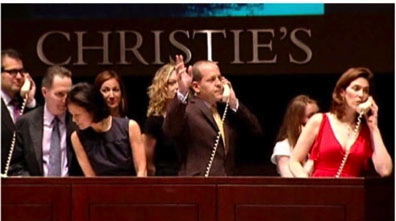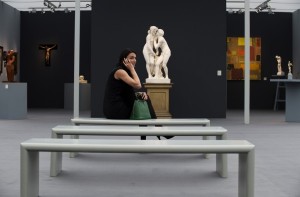Miami Art Museum officials are more than halfway to their goal of raising millions in private donations for their new waterfront home.

Seeing is believing for donors to the new Miami Art Museum now under construction alongside Biscayne Bay in downtown’s Bicentennial Park.
With elevated platforms resting atop columns, a trellis-like roof, and a grand staircase that opens onto the water’s edge, the MAM building designed by the Swiss firm of Herzog & de Meuron has generated enthusiasm among architectural critics and museum officials alike.
Lately, MAM director Thom Collins said, that sense of excitement has spread to the museum’s benefactors.
As workers give shape to the museum’s Stiltsville-inspired design, donations to the building campaign are on pace to meet the promise made by museum trustees to raise $120 million in private funds to offset the costs of construction and future operations, he said. More than half has already been pledged.
“People don’t get on board until they see things,’’ Collins said during a recent tour of the construction site. “We’re well within $2 million of finishing the bricks and mortar fundraising.’’
Collins said he is much more relaxed these days than he was last December, when it was announced that upon completion of the building in fall 2013, MAM would be renamed the Jorge M. Perez Art Museum of Miami-Dade County, or PAMM for short, in exchange for a donation of $35 million from the Miami real estate developer.
The community response was divided among those who congratulated the museum and Perez on the generosity of his gift, and those who criticized the name change for giving one person all the credit for a museum built largely with public money approved by Miami-Dade voters in 2004.
In fact, MAM will need even more public support when the new building opens because operational costs are projected to more than double from the present $4 million a year to about $10 million. Currently, MAM relies on about $2 million a year in public funds to cover the costs of exhibitions, educational programs and staff.
Many warned that the museum’s name change would hurt future private donations, which help offset those operating costs, by sending the unintended message that the institution is taken care of.
“Bringing money in is going to be harder,’’ said Miami collector Carlos de la Cruz, who along with his wife, Rosa, runs the De la Cruz Collection Contemporary Art Space in the Design District. “I think that’s incontrovertible.’’
But nearly one year since the announcement, said MAM’s board chairman, Aaron Podhurst, the fundraising campaign is riding the momentum of its unmistakable landmark rising from the ground.
“Now we’re getting excitement,’’ he said, “and we’re trying to get some of the big gifts in.’’
Yet the work of fundraising for any cultural nonprofit, he added, “never stops.’’
The guaranteed maximum price for MAM’s new building is $131 million, Collins said, but the total price tag on the project, including an endowment to ensure its future operations, is about $220 million.
Public money from a general obligation bond approved by Miami-Dade voters in 2004 will pay $100 million of that cost. Museum trustees pledged to raise an additional $120 million in private donations, including $31 million to offset construction costs, $70 million for an endowment to ensure future operations, and $19 million for transitional expenses.
Collins said MAM trustees have raised about $70.5million in pledges to date, and about $33.5 million of that sum has already been paid.
The remainder will be raised in the months leading up to the museum’s scheduled opening next year — and beyond, Podhurst said.
With much of the museum’s share of construction costs already raised from private sources, Podhurst said, MAM officials are now focused on building the endowment.
“The key for the next year and a half is to get the endowment as high as we can get it,’’ he said, “so we can really do some great operational programming.’’
Museum trustees made a number of promises to ensure that the new building does not run into the same cost overruns and delays that plagued the Adrienne Arsht Center for the Performing Arts, which cost nearly $500 million to complete and experienced numerous delays before opening in 2006.
“After the performing arts center, I think that this community was really gun shy, as I can understand,’’ said Rose Ellen Meyerhoff Greene, vice president of the museum’s board of trustees.
But Greene said museum trustees — nearly all of whom pledged gifts to the campaign — have taken a personal interest in ensuring that the new building comes in on time and on budget.
“If you’re building your own home, you hire an architect; you hire a contractor; and then you watch every light socket put in the home,’’ she said. “That’s how we’ve treated this project.’’
Among the most important commitments made by MAM trustees was management of the building’s design and construction, which ensures that any cost overruns will be paid for by the museum and not the public.
“Those are written assurances,’’ said Michael Spring, Miami-Dade’s cultural affairs chief and one of the principal public officials overseeing the project.
Spring said museum trustees signed a contract promising to raise $120 million in private donations, though there is no timetable specified for raising the funds.
If MAM fails to meet those fundraising goals, then museum trustees and benefactors will be expected to make up the difference, Spring said.
Miami-Dade and the city of Miami, which contributed about $2.8 million in bond funds to the project plus the land for the building, exercise some oversight of the project. For instance, all project costs are paid first by MAM, then submitted for reimbursement to the county and city.
Public officials also receive updates on the project through monthly meetings with museum officials, and annual reports required for receipt of bond monies.
But much of the responsibility for the project’s success rests with museum trustees.
With their own skin at stake, Collins said, museum officials have hired teams of consultants to help manage construction costs, and to gauge future operational expenses.
“We have spreadsheets, and spreadsheets, and more spreadsheets,’’ Collins said. “We really feel confident we have a handle on it.’’
According to the museum’s projections, operating costs for the new building will more than double from the current $4 million a year to about $11 million annually.
Some of that additional operating cost may be borne by the county, which already contributes about $2 million a year to the institution. But county officials have not yet made a commitment to increase funding of the museum.
“It’s inevitable that the budgets for bigger buildings will be bigger,’’ Spring said. “We understand that, but we can make no guarantees that the county can do anything more than what we’re doing now.’’
Podhurst said MAM trustees have not yet asked the county for increased public support, but he enthuses over the opportunities for generating income in ways the museum’s current home in the Miami-Dade Cultural Center cannot.
“We expect to make a lot of money in our predictions on rentals on weddings and bar mitzvahs and parties, and all that kind of stuff, because they’re beautiful spaces,’’ he said. “It’s one of the most gorgeous spots to be on the water.’’
Still, Collins makes it clear that MAM will be looking to county leaders to increase annual support of the museum, as well.
“We have to grow funding through every revenue stream,’’ he said, “but everything has to grow: government funding, private support, earned income.’’
MAM’s fundraising campaign took an unexpected turn in December when the museum announced Perez’s donation of $35 million in cash and art.
MAM trustees voted to accept Perez’s gift and the museum’s renaming by a 46-4 vote, but the news also triggered a backlash.
Four members of the museum’s board of trustees resigned, including past president Mary Frank., who with her husband Howard Frank, chief operating officer and vice chairman of Carnival Corp., vowed to stop paying on their $1 million pledge. Carnival Corp., which had pledged $5 million to the museum, also reneged.
The Franks paid $417,791 of their pledge, MAM officials said, and Carnival Corp. paid $1.5 million.
The museum does not plan to return those gifts, said Tracy Belcher, a MAM spokeswoman.
Yet while some donors have severed ties with the museum over the change, the renaming also has helped open new doors for MAM.
“The Jorge Effect was really positive and fantastic,’’ said Collins, the museum’s director, “because he’s given us access to people we otherwise wouldn’t have talked to.’’
Ranked the 360th richest person in America by the October issue of Forbes magazine, Perez, 63, has a personal fortune estimated at $1.2 billion — and he travels among a broad circle of influential friends.
His gift to MAM, divided into $20 million cash and $15 million in art, was meant to lead by example, Podhurst said.
Perez has paid $6.5 million of the cash pledge to date, Podhurst said, and he is scheduled to pay an additional $3.5 million in January. The remainder of his cash pledge — $10 million — will be paid in installments by 2022.
The art, however, is already in hand.
Collins and MAM’s chief curator, Tobias Ostrander, recently hand picked the works from Perez’s personal collection. Those works have been appraised by Christie’s, the art auction house, and their value is greater than the pledged amount of $15 million, Podhurst said.
In a video interview posted on Forbes.com, Perez said his commitment to MAM is now closer to $40 million.
But he doesn’t mind.
“I want the best pieces to go to the museum,’’ he told Forbes.
Among the donors whom Perez brought on board for the museum’s campaign is a fellow member of the Forbes 400: Number 83, Stephen Ross, the billionaire owner of the Miami Dolphins.
Though Ross sits on the boards of some of New York’s most prestigious cultural institutions, including the Guggenheim Museum and the Lincoln Center, he had not taken an active role in MAM’s capital campaign until his longtime friend, Perez, asked.
Ross, a real estate developer who is founder and chairman of the Related Companies, said he and Perez are friends and business associates dating back to 1979.
“Knowing that’s important to him, I gave it in his honor,’’ Ross said of his gift to MAM. “Jorge told me how important it was, and asked if I would be interested in giving. It wasn’t a hard sell, if you know what I mean.’’








